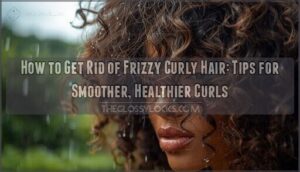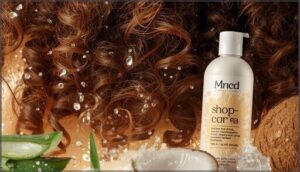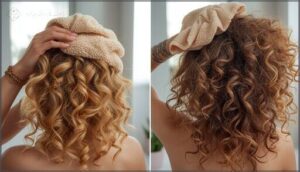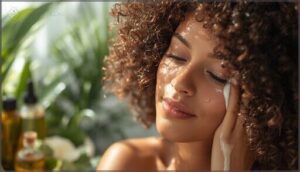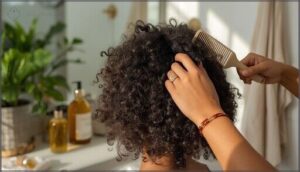This site is supported by our readers. We may earn a commission, at no cost to you, if you purchase through links.
Rain in the forecast, and your curls can sense it before you do. One step outside and the halo of frizz arrives—each strand fighting for space, rebelling against your best efforts.
Curly hair has its own moods and rules, from pillowcase friction to summer humidity, with every little quirk making smooth curls feel out of reach.
Learning how to get rid of frizzy curly hair isn’t about taming wild locks—it’s about working with your texture, not against it. Find out what really soothes thirsty spirals and gives you control over your curls, no matter what the day throws at you.
Table Of Contents
Key Takeaways
- Managing frizzy curly hair is about keeping hair hydrated with sulfate-free, alcohol-free products and adopting gentle washing, drying, and detangling routines.
- Moisture retention through deep conditioning, leave-in conditioners, and sealing with oils is key to defining curls and reducing frizz.
- Environmental factors like humidity, overwashing, and harsh products can trigger frizz, so adapt your routine and use humidity-fighting products as needed.
- Nighttime protection, regular trims, and understanding your unique curl and porosity type help you work with your texture for smoother, healthier curls.
Causes of Frizzy Curly Hair
Frizz can sneak up on curly hair for a handful of reasons, some obvious and some less so. Understanding what really causes the problem is the first step to smoother curls.
Let’s take a closer look at what’s working against you.
Friction and Physical Stress
With every brush stroke, tug, or towel rub, you’re putting your curls through a lot more than you think. Friction and physical stress—like Towel Friction, Combing Breakage, and Mechanical Tension—cause the cuticle lift that triggers frizz. Understanding credible research sources can help determine the validity of hair care advice.
Here’s what ramps up frizzy hair and breakage:
- Rubbing with rough towels
- Daily combing
- Skipping Protective Styles
- Tight ponytails or buns
- Brushing dry curls
Dryness and Hair Damage
Let dryness and damage run wild, and you’ll see frizz almost overnight. When intra-cortical moisture drops, your cuticle lift rises, leaving hair rough, thirsty, and prone to breakage.
When dryness and damage take over, frizz follows fast—leaving hair rough, parched, and dangerously prone to breakage
Weekly deep conditioning boosts moisture retention, while reparative shampoos with ceramides or amino acids can repair surface cracks, helping you lock in hydration and finally get breakage prevention that lasts.
These reviews use repeatable research methods to synthesize evidence.
Misunderstanding Your Hair Type
Misreading your hair type can send you chasing solutions that just don’t fit. Curl pattern ID and porosity awareness aren’t just buzzwords—they’re the roadmap to product efficacy and real regimen adjustment. Get them wrong, and your curls rebel.
Think about these common pitfalls:
- Overusing heavy oils on low-porosity hair
- Misclassifying curl types
- Underestimating your hair’s styling confidence
Environmental Factors and Humidity
Curly hair doesn’t just react—it rebels when the air turns thick with humidity. Porch-swing mornings or halfway through a sweaty commute, your curl pattern puffs up. That’s the Humidity’s Frizz Impact at work, and high-porosity hair feels it most.
| Climate Curl Care | Humectant Balance |
|---|---|
| Tropical = more frizz | Too much = poofy curls |
| Seasonal Haircare | Proper hair humidity protection |
| Sealed cuticles = less frizz | Balanced products matter |
Sealed cuticles and balanced products are key to managing this frizz, especially in tropical climates where humidity levels are high. Seasonal haircare adjustments can also help maintain curl definition and reduce unwanted puffiness.
Overwashing and Harsh Products
If you wash your hair too often with standard shampoos or harshly formulated products, you’re inviting frizz and dryness. Sulfate-free shampoo and alcohol-free products offer gentle cleansing without stripping your scalp.
Sulfate alternatives reduce product buildup and scalp irritation, while avoiding overwashing helps keep curls hydrated. Resist the urge to overclean—your curls will thank you for it.
Best Washing and Drying Techniques
How you wash and dry your curls makes all the difference when you’re aiming for less frizz and more definition. Small changes in your routine can quickly change the way your hair feels and looks.
Let’s look at the key techniques that help curls stay smooth and healthy.
Optimal Washing Frequency for Curls
Ever notice how your curls rebel when you overdo the hair wash? Wash frequency matters—washing every 2–4 days helps balance scalp health and keeps frizz in check. Too much washing strips natural oils; too little invites buildup and itch.
Your lifestyle and environment play a role, too, making it worth fine-tuning your routine for smoother, stronger curls.
Using Sulfate-Free, Reparative Shampoos
If you’ve ever watched your curls puff up after a hair wash, you know not all shampoos play nice. Choose a sulfate-free shampoo full of reparative ingredients instead.
You’ll protect your scalp health by skipping harsh detergents, minimize product buildup, and gently cleanse. Reparative shampoos cushion curls from damage, leaving your hair softer, shinier, and less prone to frizz.
Conditioning Methods for Moisture Retention
Think of hair conditioning like quenching thirsty soil—what you put in matters. A deep conditioner drenches strands, but long-lasting hair hydration comes from using leave-in benefits alongside oil sealing.
Try the LOC method for top-tier hair moisture retention, and don’t skip a pH-balanced product. That way, you lock in hair moisture and keep frizz out of your story.
Microfiber Towels Vs. Regular Towels
Let’s talk towel choice—because the fabric on your curls makes all the difference. A microfiber towel slashes drying time and shrinks frizz thanks to its tight weave and Friction Reduction properties. Regular towels wear out quicker, stir up frizzy hair, and sap Hair Health.
If Hygiene Practices and Environmental Impact matter, stick with microfiber for smarter curly hair drying methods.
Air Drying and Diffusing for Frizz Control
When you’re battling frizz, air-drying benefits your curls by letting cuticles settle instead of fluffing up from towel friction.
Diffuser techniques matter—use low to medium heat with a cool blast at the end to tighten curls and tame flyaways.
Combine product layering with gentle hair drying methods; avoid direct root heat to control frizz and minimize heat damage.
Essential Moisturizing and Conditioning Tips
When you want smoother curls, how you care for them matters just as much as the products you use. The right moisture and conditioning steps can help you manage frizz and bring out your hair’s best shape.
Here’s what to keep in mind as you build your routine.
Leave-in Conditioners for Curls
A good leave-in conditioner acts like armor for your curly hair, locking in hydration levels and smoothing out frizz before it has a chance to start. Focus on alcohol-free product ingredients and apply to damp hair, using fingers or a wide-tooth comb for even distribution.
Overnight protection—think silk bonnets—helps maintain curl definition and shields strands from friction.
Deep Conditioning and Hair Masks
If leave-in conditioner is your daily shield, deep conditioning treatments are your secret weapon for hair moisture and hydration. Weekly deep repair masks—whether protein treatments or nourishing overnight masks—can transform thirsty curls into softer, smoother spirals.
Boost results by adding a little heat application or trying DIY recipes. Aim for regular mask frequency: once a week keeps strands thriving.
Sealing in Moisture With Oils
After you pamper your hair with a deep mask, sealing in moisture with oils makes all the difference. Picture it as locking the front door before a storm—your curls stay smooth, not frizzy. Use these moves for success:
- Pick hydrating oils (argan, jojoba)
- Apply to damp hair
- Start light, build if needed
- Watch for heaviness or buildup
LOC Method for Frizz Control
Think of the LOC Method as your blueprint for keeping curly hair defined and frizz-free. Layer a leave-in conditioner, then seal with hair oil, and finish with cream—this order boosts hydration levels and manageability. Many see smoother curls (up to 25% less frizz) and real humidity resistance.
Here’s how it stacks up:
| LOC Steps | Product Order | Hydration Levels |
|---|---|---|
| Leave-in conditioner | Leave-in first | Highest |
| Oil | Oil second | Locks in moisture |
| Cream | Cream last | Guards definition |
| Reverse order | Cream or oil first | Lower |
| No routine | — | Inconsistent |
PH-Balanced Products for Cuticle Health
When you reach for hair products balanced within the ideal pH range of 4.5–5.5, you’re giving your hair cuticle what it craves most—smoothness and real moisture retention. That translates into visible frizz reduction, fewer flyaways, and easier manageability.
Over time, this routine helps rebuild hair health, locking in shine while keeping damage and frizz at bay.
Product Selection for Frizz-Free Curls
Choosing the right products can make or break your curly hair routine. With so many options on the shelves, it’s easy to feel overwhelmed by what actually works.
Here’s what you need to know when picking products that keep frizz in check.
Alcohol-Free and Sulfate-Free Formulas
Want to know the secret behind soft, defined curls? Gentle Cleansing with alcohol-free products and sulfate-free shampoos is a revelation for frizzy curly hair. Here’s why your Product Selection matters for Long-Term Health:
- Maintains Moisture Retention, preventing dryness.
- Ingredient Benefits nourish, not strip, sensitive strands.
- Helps hair products for frizz work smarter, not harder.
Curl Creams, Gels, and Serums
When you want total control over frizz and curl shape, lean into smart product layering. Curl creams, gels, and hair serums each play a part. Here’s how it breaks down:
| Styling Product | Main Perk | Ideal Use |
|---|---|---|
| Curl Cream | Moisture, bounce | Damp hair prep |
| Gel | Strong hold, control | Lock style, finish |
| Serum | Shine, humidity block | Final smoothing |
With the right match—moisturizing Cream Ingredients, proper Gel Application, and a boost from Serum Benefits—your curls look defined, not crunchy. Mix up your styling products to suit the weather and level of hold strength you crave.
Anti-Humidity Sprays and Serums
Humidity has a way of sneaking in, making your best hair days go rogue. That’s where anti-humidity sprays and serums step up—modern frizz control products blend smart humidity-blocking ingredients with lightweight hair serum textures.
Application techniques matter: work serums through damp hair, focusing on mid-length to ends, for lasting humidity control. Expect softer curls and real protection.
Ingredients to Avoid for Curly Hair
Chasing smooth curls? Watch out for stealthy troublemakers like Sulfate Detergents, Drying Alcohols, and Non-Soluble Silicones—these strip moisture and spark frizz before you know it.
Mineral Oil and Formaldehyde Preservatives can feel like a “quick fix,” but they weigh down curls or irritate scalps.
Go for alcoholfree products and skip sulfates to keep curly hair strong, soft, and vibrant.
Using Lightweight Vs. Heavy Products
Too much weight on your curls is like throwing a wet blanket on a fire—definition and bounce get smothered. Lightweight leave-in conditioners and alcohol-free products keep curls airy, while heavy creams can encourage Product Buildup and dull curls.
For best results:
- Choose sulfate-free shampoo for scalp health.
- Favor lightweight formulas for Curl Definition.
- Rotate anti-humidity products.
- Balance moisture by porosity.
- Clarify regularly.
Styling and Maintenance Tips for Smooth Curls
Keeping your curls smooth takes more than just the right products—it’s all about the way you care for them day to day. These styling and maintenance habits can make a real difference.
Here’s how to keep your curls looking their best.
Gentle Detangling Methods
How do you outsmart knots that want to rule your curls? Start wet detangling after a fresh wash, working in sections and letting product application do the heavy lifting.
Switch to a widetooth comb instead of hair brushing for friction-free detangling. Use gentle strokes—from ends upward—for hair detangling that preserves your pattern and sets the stage for frizz-free, hydrated hair.
Minimizing Heat Styling Damage
After gentle detangling, let’s set some boundaries with heat. Lowering the temperature on your tools and reaching for a heat protectant spray can save your curls from breakage. Swap daily heat styling for air drying or diffuser usage, and keep sessions brief. Protecting hair from heat isn’t just routine—it’s what keeps curls bouncy, smooth, and vibrant.
- Use a heat protectant spray before every hot tool
- Choose a temperature below 320°F whenever possible
- Limit heat styling frequency to once a week or less
- Air dry or opt for a diffuser to minimize direct heat
Nighttime Protection (Silk Bonnets & Pillowcases)
Letting go of heat tools at night? That’s when a silk bonnet or pillowcase steps in for your curls. Silk vs. satin? Both minimize friction and offer moisture retention, but silk shines for breakage reduction.
Just make sure your bonnet fit is snug, not tight. Treat your fabric well—gentle washing preserves glide. Pair with a silk scarf for even better hair protection and less frizz.
Regular Trims and Split End Prevention
Swapping out your pillowcase is only half the story—Trim Frequency matters too.
Regular hair trimming cuts off split ends before they get wild, keeping curly hair less frizzy and easier to manage. Whether you grab reliable trimming tools for a DIY trim or trust a pro haircut, schedule trims every six to eight weeks. Your curls will thank you with smoother definition.
Quick Fixes for Frizzy Hair Emergencies
Ever wake up to a halo of frizzy curly hair? In a pinch, grab a silicone-based serum for quick frizz control, or mist on water and follow with a light leave-in for leave-in benefits. Blot, never rub, with a microfiber towel—towel material matters.
When fighting humidity, use spray protection. For instant smoothness, oil smoothing tames strays fast.
Frequently Asked Questions (FAQs)
Can diet affect the frizz level of curly hair?
Like a garden that needs the right soil, your curls thrive on nourishment. Omega-3 intake, zinc benefits, and proper hydration can quietly decrease frizz, while protein impact and vitamin deficiencies reveal how diet weaves into hair health.
How does water hardness impact frizz in curls?
Hard water effects show up fast on curly hair—mineral buildup roughens cuticles, making frizz worse.
Minerals disrupt conditioning agent absorption, and when humidity hits, frizzy hair spikes.
Use chelating products and pH-balancing rinses for practical mitigation.
Are there salon treatments specifically for frizzy curls?
Ready to turn the tables on your frizz? Salon hair treatment options like Keratin Treatment, Brazilian Blowout, Olaplex Benefits, Protein Reconstructors, and Glossing Sealers all specialize in curly hair repair, fighting frizzy hair for smoother, healthier curls.
What’s the role of genetics in persistent frizz?
Frizz heritability means genetics shape much of your hair’s texture, curl pattern, and cuticle integrity.
Certain gene interactions—especially in hair morphology—make some people’s hair more prone to frizzy hair, even with careful, individual care routines.
Will cutting hair short reduce frizz in curls?
Cutting curly hair short can help reduce frizz by minimizing breakage and improving moisture distribution. Shorter lengths often reveal your natural curl pattern, but go too short without moisturizing and rebound frizz risk creeps in fast.
Conclusion
Think of your curls like a field of wildflowers—unique, resilient, and thriving with the right care. Learning how to get rid of frizzy curly hair means making peace with each twist and coil, rather than forcing them into line.
Choose products that nourish, adopt habits that respect your hair’s needs, and protect what you grow.
Smooth, healthy curls aren’t just about surface shine—they’re about freedom, confidence, and owning every strand, no matter what the weather brings.

